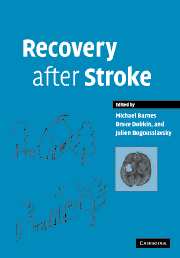Book contents
- Frontmatter
- Contents
- List of authors
- Preface
- 1 Stroke: background, epidemiology, etiology and avoiding recurrence
- 2 Principles of recovery after stroke
- 3 Regenerative ability in the central nervous system
- 4 Cerebral reorganization after sensorimotor stroke
- 5 Some personal lessons from imaging brain in recovery from stroke
- 6 Measurement in stroke: activity and quality of life
- 7 The impact of rehabilitation on stroke outcomes: what is the evidence?
- 8 Is early neurorehabilitation useful?
- 9 Community rehabilitation after stroke: is there no place like home?
- 10 Physical therapy
- 11 Abnormal movements after stroke
- 12 Spasticity and pain after stroke
- 13 Balance disorders and vertigo after stroke: assessment and rehabilitation
- 14 Management of dysphagia after stroke
- 15 Continence and stroke
- 16 Sex and relationships following stroke
- 17 Rehabilitation of visual disorders after stroke
- 18 Aphasia and dysarthria after stroke
- 19 Cognitive recovery after stroke
- 20 Stroke-related dementia
- 21 Depression and fatigue after stroke
- 22 Sleep disorders after stroke
- 23 Technology for recovery after stroke
- 24 Vocational rehabilitation
- 25 A patient's perspective
- Index
15 - Continence and stroke
Published online by Cambridge University Press: 05 August 2016
- Frontmatter
- Contents
- List of authors
- Preface
- 1 Stroke: background, epidemiology, etiology and avoiding recurrence
- 2 Principles of recovery after stroke
- 3 Regenerative ability in the central nervous system
- 4 Cerebral reorganization after sensorimotor stroke
- 5 Some personal lessons from imaging brain in recovery from stroke
- 6 Measurement in stroke: activity and quality of life
- 7 The impact of rehabilitation on stroke outcomes: what is the evidence?
- 8 Is early neurorehabilitation useful?
- 9 Community rehabilitation after stroke: is there no place like home?
- 10 Physical therapy
- 11 Abnormal movements after stroke
- 12 Spasticity and pain after stroke
- 13 Balance disorders and vertigo after stroke: assessment and rehabilitation
- 14 Management of dysphagia after stroke
- 15 Continence and stroke
- 16 Sex and relationships following stroke
- 17 Rehabilitation of visual disorders after stroke
- 18 Aphasia and dysarthria after stroke
- 19 Cognitive recovery after stroke
- 20 Stroke-related dementia
- 21 Depression and fatigue after stroke
- 22 Sleep disorders after stroke
- 23 Technology for recovery after stroke
- 24 Vocational rehabilitation
- 25 A patient's perspective
- Index
Summary
Introduction
In early childhood, the achievement of continence is a major goal and attracts great reward when it is successfully mastered. Following this, continence is forgotten – it is simply assumed to exist. The occurrence of incontinence in adult life is associated with shock, embarrassment, and often fear. It may have far-reaching effects on lifestyle. Patients have described becoming housebound because of fear of incontinence. Fecal incontinence may be even more distressing and have a profound effect upon rehabilitation and reintegration into social and family life. It has been termed the “unvoiced symptom” (Leigh and Turnberg, 1982). In a study amongst 115 patients with spinal cord injury, bowel dysfunction was considered to be one of the most distressing of their disabilities (Glickman and Kamm, 1996).
Daily urinary incontinence is not uncommon, affecting at least 1 in 20 of those under 65 years and increasing with age (Brittain, 1998). There may be a reticence about disclosing the problem even to a health professional. People may have too low an expectation of benefit from treatment and yet there is much that can be offered to alleviate symptoms (Yarnell et al., 1981; Jarvis, 1993).
Urinary incontinence
Urinary incontinence is defined as the involuntary leakage of urine that is a social or hygienic problem and is objectively demonstrable (Anon., 1990).
Prevalence
A survey by MORI involving interviews with 4000 people aged 30 years and over, in their own homes, revealed that 14% of women and 6.6% of men had experienced urinary incontinence. The definition of urinary incontinence used in the study was a positive reply to the question, “Have you suffered from bladder problems, for example leaking, wet pants, damp pants?” (Brocklehurst, 1993). Half of those with incontinence had seen their general practitioner. An earlier study involving a postal questionnaire sent to 22 430 people used a definition of regular urinary incontinence as “involuntary excretion or leakage of urine in inappropriate places or at inappropriate times twice or more a month.” This study revealed a prevalence of urinary incontinence of 8.5% in women and 1.6% in males aged 15–64 years. These figures rose to 11.6% of women and 6.9% of males aged 65 and over (Thomas et al., 1980).
- Type
- Chapter
- Information
- Recovery after Stroke , pp. 415 - 435Publisher: Cambridge University PressPrint publication year: 2005
- 2
- Cited by



